Livestock access to watercourses
Learn about the impact of livestock grazing near watercourses, and how you can protect a watercourse from contamination. This technical information is for commercial livestock producers in Ontario.
ISSN 1198-712X, Published April 2008
Introduction
Livestock grazing on lush green pastures are a pleasant picture for farmers and people driving through the countryside and an integral part of many livestock farms. However, grazing livestock with unrestricted access to watercourses can give this picture a different hue. Challenges associated with this practice can include contamination or erosion caused by the drinking animals, and heightened public awareness of the impact of livestock on water quality.
This factsheet outlines several strategies farmers can use to protect these watercourses. Fencing, strategic positioning of shade, salt, minerals and alternate sources of water, as well as grazing management plans (GMPs) can all create win-win opportunities for both the farmer and the environment.
See the Ontario Ministry of Agriculture, Food and Rural Affairs (OMAFRA) publication, Best Management Practices: Streamside Grazing, order no. BMP 19, for a more detailed discussion on grazing management plans and sensitive areas.
Erosion
Livestock trampling the banks of the watercourse as they drink can cause loss of vegetative cover, leading to increased streambank erosion directly into the watercourse (Figure 1).
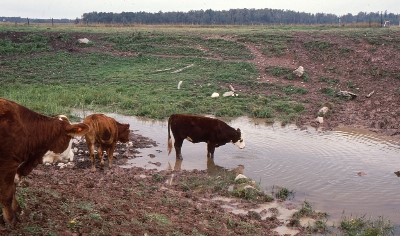
Soil compaction, also caused by drinking animals, reduces water infiltration rates, increasing runoff and sediment loading in the bed of the watercourse, resulting, in turn, in increased turbidity and nutrient loading.
Water quality
Livestock manure in a watercourse is a source of bacteria and other microorganisms. Some of the "bugs" found in manure, such as E. coli and a parasite known as Cryptosporidium, can cause sickness.
Public image
On a given watercourse, there may be more significant contributions to surface water pollution than livestock access to the watercourse, but there are few contributors more visible than livestock wandering through a watercourse, especially when it is close to a busy road (Figure 2). An animal urinating or defecating in the watercourse or along the bank is certainly a negative image to the public.
This image works against the significant involvement and investment by farmers, both as individuals and collectively through farm organizations and commodity groups, in product promotion and proactive initiatives such as the Environmental Farm Plan program.
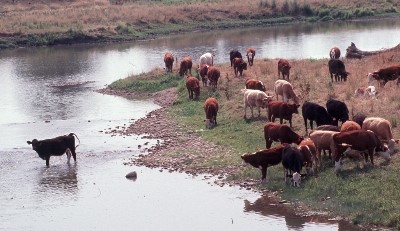
Animal performance and behaviour
Research trials have suggested that animals provided with an improved water source (not direct access to a watercourse) may have improved performance in the form of larger weight gain. Because animals are bought and sold on the basis of weight, larger weight gains are seen as "improved" performance.
From the standpoint of animal husbandry, it makes logical sense that animal performance will be improved by access to a cleaner source of water than that in a stagnant and muddy watering hole. There are anecdotal reports of improvements with animal health associated with improved watering systems, including lower incidences of:
- foot rot: a bacterial infection of the hoof
- black leg: a bacterial infection in cattle that can be fatal
- mastitis: an infection of the mammary gland (udder)
Research into animal behaviour shows opportunities for the livestock producer and the environment. Trials have shown that, 80% of the time, animals will drink from an alternate water source rather than a nearby watercourse if they are given a choice.
Deterrents
Animals can be kept from the banks of watercourses through a number of means. By moving salt and mineral away from the watercourse, animals will spend less time in and around the watercourse. Similarly, if shade trees near a watercourse are removed, animals will congregate in and near the watercourse for less time. Strategically placed rocks and shrubbery along the banks can also help deter livestock access to the watercourse.
Fencing
Fencing separating livestock from watercourses (Figure 3), combined with provision of alternate water sources, is even more effective.
Signs that you may need to consider fencing:
- "bare-spots" in the riparian area that lead to erosion
- areas in the watercourse that are muddy as a result of access
- areas where animals congregate (e.g., shade, salt and mineral feeders) near the watercourse
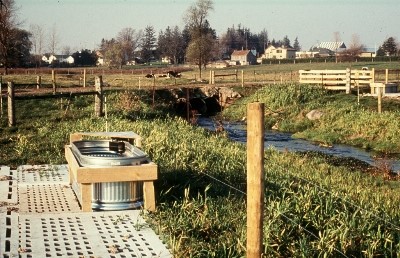
In these situations, if livestock cannot be kept from trampling the bank to allow vegetative cover to establish and maintain itself, fencing off some or all of the watercourse in the pasture may be justified.
While it is true that building and maintaining fences cost money, it may be possible to increase stocking rates with fencing through rotational grazing on the remaining area, which can increase a farmer's return from the pasture. In addition, a grazing management plan (GMP) that includes fencing may allow you to build your "forage reserve" through rotation, extending your grazing season later into the fall period, thereby saving conserved feeds and money.
Grazing and watercourses
Grazing or confinement areas can be high-density (intensive) or low-density (extensive
In this factsheet, "intensive" grazing areas will be defined as having at least 1 nutrient unit (NU) per acre for the (six-month) grazing season, e.g., 240 meat ewes and their lambs (30 NU) grazing on 30 acres, or 30 beef cows and their calves (30 NU) on 30 acres. In intensive grazing areas, animals may require supplemental feed to meet their nutritional needs or may be following an advanced grazing management plan that involves rotational-rest grazing strategies.
Intensive grazing with unrestricted access will typically have more severe impacts on water quality than extensive grazing. The high density of animals in the area leads to:
- direct defecation and urination in the watercourse
- reduced bank stability
- soil erosion
- poor conditions for vegetation growth
Many of Ontario's unimproved pastures provide "extensive" grazing — defined here as having stocking densities less than 1 NU/acre. Such pastures will have fewer animals per acre and typically provide all the nutritional needs of the animals.
Intensive grazing areas
For intensive grazing areas, the standard recommendation is complete exclusion of the animals from the watercourse, usually by fencing, and provision of an alternate water source (Figure 4). The only other option may be a grazing management plan that allows for full vegetated cover on the streambanks and riparian area and a rest-rotation cycle that only allows animals in an area for a short period of time when the soil is dry (to avoid compacting and punching up). Bear in mind that neighbours may object to even infrequent or "managed" access to the watercourse by livestock.
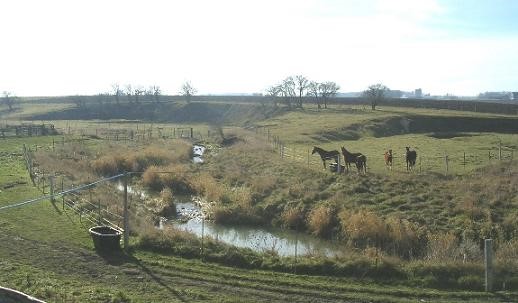
Extensive grazing areas
In extensive grazing areas, even though there are fewer animals, some fencing of riparian areas and streambanks of the watercourse may be required to maintain vegetation and keep streambanks stable in areas more prone to erosion, such as steep slopes (Figure 5).
In addition, providing an alternate water source away from the banks of the watercourse will help deter the livestock from the watercourse (Figure 4). Providing salt, mineral and shade away from watercourses will also help reduce access and impact.
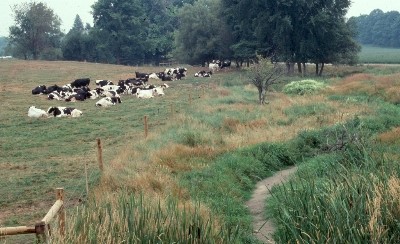
Scenarios
Consider the following two examples concerning livestock access to surface water.
Scenario 1
Challenge
A herd of 40 beef cows and their calves are confined in an 8-ha (20-acre) field. Because of the large number of animals, there are several bare areas with no growing vegetation, and the remaining vegetation is grazed to the ground. The farmer is supplying hay to the cows from early summer onward. A stream passes through the area, and the banks are predominantly bare and "punched-up" from repeated access to the watercourse when the soil is saturated. A caller to the district Ministry of the Environment, Conservation and Parks office has complained about this situation.
Solutions
The common recommendation for situations such as this is to fence the livestock entirely out of the watercourse and provide an alternate source of water for the animals.
A grazing management plan (GMP) allowing access would only be appropriate if it allows for the vegetation in the riparian area (the land adjacent to the watercourse) to establish and grow, because the animals only have access to part of the area in the paddock for a short period of time (maximum of a few days) and then move on to another area so as to stabilize the banks and minimize erosion. It is important to note that either option here involves fencing.
Scenario 2
Challenge
A herd of 20 cows and calves is grazing on a 40-ha (100-acre) unimproved and bush pasture in cottage country. A river adjacent to the property forms the southern boundary of the pasture and is the only source of water for the cattle. Located approximately 200 m down the river are 30 rental cottages. Due to the stony shoreline, the cattle access at the river is limited to three points, and there is good vegetative cover along the banks of the river. The owner of the cottages wants the cattle fenced from the river but does not want to jeopardize the good relationship he has had with the farmer in the past. The farmer is aware of the public attention that the cows in the watercourse are generating but has resisted fencing in the belief that spring floods and ice flows would likely damage or destroy the fence (Figure 6).
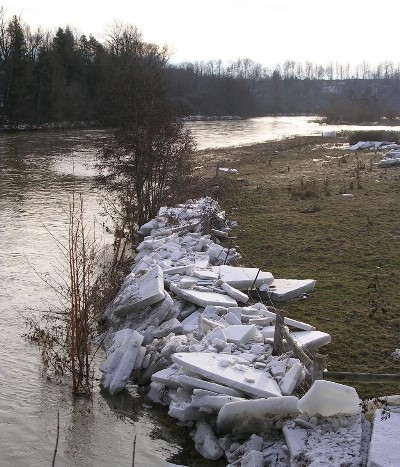
Solutions
While any manure and urine directly deposited in the water by the animals will have an impact on water quality, the severity of impact on water quality from livestock access in this scenario will not be as great as in Scenario 1 because of the lower number of animals, good vegetative cover on the banks and a relatively large volume of water (Figure 7). However, remember that, in such situations, there are public image issues to consider.
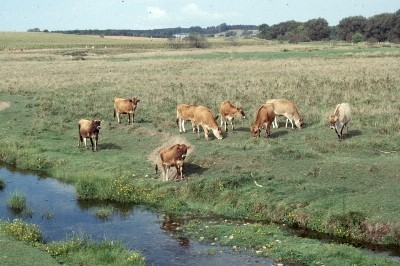
The farmer may be able to further limit access by providing an alternate water source and moving salt, mineral and shade away from the watercourse. However, the farmer should talk with the cottage owner to explain that steps have been taken to reduce access to the watercourse, that any fencing installed would probably not survive spring flooding, and that animals still might be in or near the water from time to time.
There may also be an opportunity here for neighbours to work together. Would the neighbouring cottage owner allow a water line from his pressure system to run down to the pasture, thereby providing the cattle with an alternate water source? Could a neighbour allow a fence energizer to be plugged into his or her power supply? This type of cooperation can result in cost-effective solutions and positively build upon good working relationships in the community.
Conclusion
Livestock access to watercourses can have a negative impact on water quality. The negative impacts are magnified or made worse by high livestock densities, bare or eroded banks, compacted soil and "punched-up" areas.
Public image is an important factor for the farmer to consider. Any livestock access to a watercourse, even minimal or managed access, may result in complaints from others.
Aside from using fencing, farmers can discourage livestock access to watercourses by moving salt and mineral feeders and locating shade away from the watercourse. These practices help maintain vegetation along the banks in extensive or low-density grazing areas.
The development and implementation of grazing management plans can result in win-win situations for the farmer and water quality. With appropriate fencing and rest-rotation strategies, water resources can be protected and pasture areas can be more productive, often allowing more animals to graze or extending the length of time that animals can graze each year.
This factsheet was written by Peter Doris, Environmental Specialist, OMAFRA, Brighton, and reviewed by Robert P. Stone, P. Eng., Engineer, Soil, OMAFRA, Brighton; Jack Kyle, Grazing Specialist, OMAFRA, Lindsay; and Doug Johnston, Agricultural Compliance Officer, Ministry of the Environment, Peterborough.
A quick overview of some relevant legislation
This is not intended to be a complete discussion of all legislation, but rather a quick overview for the reader of some of the common legislation related to livestock access to surface water. For a complete text of these statues, go to www.ontario.ca/laws unless otherwise noted.
Ontario Water Resources Act
Deals with water pollution issues, permits for septic and sewage works and wells along with other legal aspects related to water. Any work in or around a watercourse may require permit under the OWRA (check with MECP or local conservation authority for permit requirements).
Environmental Protection Act (Ontario)
This legislation has been paraphrased as the "thou shalt not pollute" legislation. It includes a provision that states farmers are exempt if discharge is a result of a normal farm practice.
Fisheries Act (Canada)
Protects fish and fish habitat. Penalties can be levied because of destruction of fish habitat or if harmful or deleterious substances enter a watercourse.
Nutrient Management Act (Ontario)
Focuses on management of nutrients, especially nutrients intended for application on agricultural land. On farms required to have a nutrient management strategy, livestock are not allowed access to surface water in high-density, permanent outdoor confinement areas, such as some feedlots or barnyards or if there are 300 NU or greater annually in the permanent outdoor confinement area.
Conservation Authority Act (Ontario)
Any work in a designated floodline area mapped by the local conservation authority (CA) will require a permit from the CA before starting work. For example, installation of a bed-level crossing or a mid-level crossing (i.e., with a culvert) would require a permit before starting work. For more information, contact your local CA or municipality.
Drainage Act (Ontario)
Allows the local municipality to construct a "municipal drain" to serve as a communal drainage system for an area of landowners. These drains are considered municipal infrastructure, so the municipality has a right-of-way along the drain to allow it access to perform maintenance repair work on the drainage system. If livestock access to a municipal drain causes damage or blocks the drain, the municipality can charge the cost of repairs back to the property owner.
Before constructing fences along a municipal drain, check with the municipality to ensure that the location of the fence will not restrict the municipality in performing necessary maintenance and repair work.
Clean Water Act (Ontario)
A newly proclaimed piece of legislation in Ontario at the time of writing this factsheet. This Act will primarily deal with protecting municipal and communal water sources whether it be from wells or surface water.
Footnotes
- footnote[1] Back to paragraph Ontario Soil and Crop Improvement Association.
- footnote[2] Back to paragraph The Canada-Ontario Environmental Farm Plan Program - Third Edition Workbook. 2004. Ontario Farm Environmental Coalition, Agriculture and Agri-Food Canada and Ontario Ministry of Agriculture, Food and Rural Affairs, uses the terms "intensive" and "extensive" for the risk assessment that farmers undertake when completing their EFP book, however the EFP binder does not set an arbitrary threshold of 1 NU per acre for the grazing season, as noted in this Factsheet.